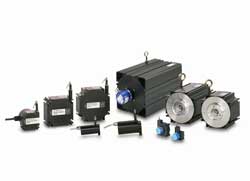
Posted to News on 1st Jun 2007, 16:14
Draw wire sensors with analogue and digital outputs
With applications that range from general industrial machinery and lifting platforms, through to more specific uses such as dentist chairs, patient lifting tables, theatre stages, pneumatic and hydraulic systems, aircraft landing gear and forklift trucks, Micro-Epsilon's wireSENSOR range of digital and analogue draw-wire displacement sensors are proving very popular with machine builders and OEMs who require low-cost, robust, reliable sensors that can be easily integrated into existing machines, components or control and automation systems.

The principle of a draw-wire displacement sensor is relatively straightforward, hence its inherent reliability. The sensor works rather like a tape measure, except with a draw-wire sensor, the user does not have to read off the measurement of the extended tape. The rotation of the drum on which the steel wire is wound is measured automatically, and the drum incorporates a long-life spring drive that ensures the steel wire is rewound.
Micro-Epsilon's wireSENSOR range uses three main measurement methods: a multi-turn potentiometer, an incremental encoder or an absolute encoder. One of these devices is mounted onto the drum axle, converting the rotary motion of the drum into a signal that can be evaluated. The measured displacement can be output as an analogue current, voltage or potentiometric signal. For a digital output, there is a choice of HTL or TTL, with interfaces for most of the common fieldbus systems, including CANopen, SSI and Profibus.
Conquering corners
As with traditional tape measures, the wireSENSOR series is capable of measuring around corners and edges. Micro-Epsilon supplies as accessories deflection pulleys, which deflect the steel wire in the desired direction.
Customers of Micro-Epsilon draw-wire sensors are not restricted by measurement range either. The sensors cover a measuring range from 50mm right up to 50m. Options are available for harsh environments too, with an IP67 version available.
Micro-Epsilon's draw-wire sensors normally come with a plastic housing; however, for more arduous applications, an aluminium housing is provided. Accessories for the sensors include brackets, wire extensions, deflection pulleys and various magnetic holders for the sensor and wire.
The draw-wire mechanism is also available separately with an adaptor for the customer's own encoder. In this way, companies that have their own appropriate encoder technology but do not manufacture their own draw-wire sensors, can offer their customers a suitable complete system.
Typical applications
Applications are many and varied. In the medical industry, draw-wire displacement sensors are being used on CT scanner machines, X-Ray systems, medical bath tubes, ambulance stretchers, dentist chairs, wheelchairs and rehabilitation equipment.
In the automotive sector, applications include crash test dummies, vehicle suspension systems, engine vibration and pedal position. Garbage trucks, forklift trucks and mobile safe working platforms also use draw-wire sensors.
Companies in the aerospace industry are using draw-wire sensors to check landing gear, wing structure and simulator positioning. Manufacturers of industrial presses, saws, foil welding machines and gluing machines are also using Micro-Epsilon's wireSENSOR.
Satellite deployment
One of the more unusual applications for Micro-Epsilon draw-wire sensors was for the release of a satellite into space, where the key design considerations were high reliability and linearity. In order to be able to launch the satellite from the Ariane rocket unobstructed into space, the nose cone section, together with the side shield, had to be separated from the main rocket immediately before the release of the satellite.
Simultaneous and controlled activation of a series of preloaded springs provided the propulsion force for the separation of the nose cone and side shield. But it was critical that the section separated itself in an absolute linear motion from the main rocket, without any non-linear tumbling movement that could cause damage to the satellite.
Three custom-designed Micro-Epsilon WDS-500-MP-P-SPL draw-wire sensors were mounted on the booster rocket and used to control the separation movement. The ends of the draw wires were attached to the nose cone section via a preset breaking point connector, which automatically disconnected the wire from the nose cone at the end of the measuring limit of the sensors.
Immediately following the separation of the draw-wire from the nose cone section, the wire is automatically retracted into its housing, so as to avoid damage to the satellite during its subsequent separation from the carrier.
Car production
In elevating platforms for car production, one of the main features is that the sensor must operate very robustly and not be susceptible to faults. The resolution must be extremely high over the whole measurement range. Therefore Micro-Epsilon's type P60/P96 draw-wire sensors are used, which have a measuring range from 1m up to 3m.
The measuring wire of the P60, which has a diameter of 0.45mm, is made from stainless steel and is sheathed in polyamide. With the P96, the wire has no polyamide sheath and is 0.8mm in diameter. These very compact sensors can be accommodated easily inside elevating platforms. Installation of the sensors is straightforward, as mounting grooves are provided on all sides. Suitable tenon blocks can be fitted easily and quickly in most installation conditions.
No. 1 Shorelines Building
Shore Road
CH41 1AU
UNITED KINGDOM
+44 (0)151 355 6070






























